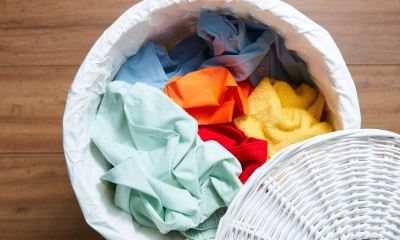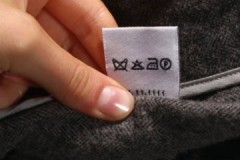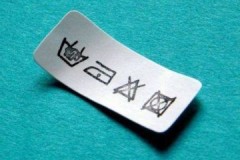We follow the rules: which things can be washed together, which ones are not recommended and why
 Now there are many varieties of things of different colors and materials from which they are made.
Now there are many varieties of things of different colors and materials from which they are made.
In order for them to retain their original appearance for a long time, it is necessary to adhere to certain rules: this includes the choice of washing powder and fabric softener, washing mode and temperature, and also, it is worth paying due attention to proper sorting.
Read the article about what things can and cannot be washed together in a washing machine and how to do it correctly.
Content
- Do I need to sort different clothes before washing them in a washing machine, what could be the consequences?
- How to correctly determine compatibility?
- How can you tell if a product is fading if there is no label?
- Sort by color
- Sorting laundry of the same color
- We separate one from the other according to the type of fabric
- Distribution by functional features
- Successful combinations
- Conclusion
Do I need to sort different clothes before washing them in a washing machine, what could be the consequences?
Often, dirty laundry is simply collected in the general wash, loaded into the machine and, having selected a mode, the process is started. At best, you might get lucky and nothing bad will happen.
But, in the end, such actions will lead to negative consequences, for example:
 If you do not take into account the material from which the item is made and choose the wrong mode on the washing machine, then it may shrink.
If you do not take into account the material from which the item is made and choose the wrong mode on the washing machine, then it may shrink.- Mistakes in choosing detergents for washing a particular type of clothing can ruin its appearance. For example, colored ones may lose their brightness, and white ones may fade or acquire a grayish tint.
- Washing white clothes together with colored ones, which tend to fade, can radically change the color of a light-colored item. The water will be colored and give a different shade to the white item. For example, if you wash it with red clothes, you may end up with a pink item.
- It is better not to combine items when washing that do not correspond to their intended purpose. For example, bed linen with sneakers and so on.
How to correctly determine compatibility?
The most important assistant in sorting laundry is the label from the manufacturer. Usually it contains all the necessary data: the material of manufacture, the required temperature and washing mode, whether the item sheds, as well as what is strictly contraindicated to do.
How can you tell if a product is fading if there is no label?
Manufacturer's labels on the inside of clothing can be uncomfortable when in contact with the skin, so some people remove them.
If the item does not have such a label, There are several ways to determine whether she is shedding:
-
 Some clothing manufacturers, especially branded ones, can sew a small piece of fabric on the inside of the item.
Some clothing manufacturers, especially branded ones, can sew a small piece of fabric on the inside of the item.If one is present, it must be cut off, treated with ammonia, it will be enough to simply moisten it, and wait from ten to twenty minutes.
After this, rinse and dry. If after performing this procedure the flap retains its original color, then the item does not fade.
- If such a flap is missing, then you should not use this method, even on an inconspicuous area of the product. To determine whether an item is shedding or not, you just need to dampen a small area of the fabric. After this, it is ironed, after placing a paper napkin.If it doesn’t become colored during the process, then everything is fine.
Sort by color
There are certain guidelines on how to sort items by color, but the washing process will become much more difficult if you adhere to them unquestioningly. To simplify, you can use combinations with shades. Let's take a closer look at the general rules and possible combinations of things by color.
Which ones are allowed to be processed simultaneously?
You can wash items of the following colors and shades together:
-
 Due to the peculiarities of the choice of powder and washing temperature, dark clothes should be washed separately from everyone else, but there are exceptions to the rule.
Due to the peculiarities of the choice of powder and washing temperature, dark clothes should be washed separately from everyone else, but there are exceptions to the rule.This category is diluted with clothing in dark colors: marsh, blue, brown, khaki, purple and similar shades.
- The same rules apply to white things. It is allowed to wash clothes of light, pastel colors together. They also add light-colored items that contain a small color pattern or design.
- Separate rules apply for colored items. Wash them using detergents for colored clothes. You can add light items with large-scale bright, colored designs or patterns.
There is no need to separate sorting by color shades, but it is important to know that it is not recommended to add clothes that may fade to this category. You can take a risk and turn such a thing inside out. This will greatly increase the chance of not ruining other items, but it is best to wash it separately.
Which ones are not allowed?
It is not recommended to combine the following shades and colors:
- White and black. These colors have completely different washing modes, in particular, temperature and choice of powder and conditioner. When washing light colors, bleach or strong detergents are often used; in this case, black clothes may lose their original color.
Dark laundry is washed at low temperatures, which will negatively affect the quality of white laundry. Well, the last thing worth noting is that dark things that tend to fade will give light-colored linen a grayish tint.
- Colored and white. Low temperatures will reduce the effectiveness of washing whites. For each of these categories, special powders are used. Therefore, combining will not bring the desired results, but will only reduce the overall quality of the washing process.
- Colored and black. Although these categories have common temperature indicators, they have features related to the choice of chemicals. Therefore, it is not recommended to combine them. With the exception of shades that are as close as possible to black.
Sorting laundry of the same color
 In this case, you need to look at the information from the manufacturer, which is indicated on the label. You can make this procedure easier using a number of general rules:
In this case, you need to look at the information from the manufacturer, which is indicated on the label. You can make this procedure easier using a number of general rules:
- look at what the thing is made of;
- do not ignore the specified temperature and washing mode;
- Choose your powder and special detergents wisely.
Sorting by color is important, but items also need to be sorted by fabric type.
We separate one from the other according to the type of fabric
For the different materials from which clothes are made, there are certain recommendations for choosing a washing product and choosing the right mode.Some categories can be combined, but there are materials that are best washed separately or even by hand.
Suitable for co-washing:
- cotton, linen, calico items;
- woolen And cashmere cloth;
- synthetics cannot be combined with other types - polyester, nylon, acrylic, polyamide, viscose, synthetic velor.
Delicate fabrics should always be washed separately, preferably by hand. For these cases, purchase special products separately and pay special attention to studying the label from the manufacturer.
Distribution by functional features
The final stage of sorting will be identification by functional features. Most of these rules are known to everyone, since they are quite logical, but it will not hurt to familiarize yourself with them:
-
 Bad combination. Shoes, For example sneakers, always wash separately. Baby clothes goes into a separate category.
Bad combination. Shoes, For example sneakers, always wash separately. Baby clothes goes into a separate category.Curtains, curtains, blankets, rugs, jackets and down jackets - apart. Heavily soiled items and those that require light washing are also separated.
- Good combination. Bed linen belongs to a separate category; it is permissible to add terry towels. Jeans - only with socks. The rest is selected according to shade, material, and total weight.
Successful combinations
Let's look at a few examples of good linen combinations:
- Cotton, chintz, light-colored items.
- Black and dark colored underwear.
- Jeans and socks.
- Any synthetic clothing.
You will find maximum useful information about washing clothes and various fabric products Here.
Conclusion
At first glance, the sorting procedure may seem complicated, especially to inexperienced housewives. But in reality there are not many rules and it will not be difficult to understand them. After 2-3 washes you will understand the main points and everything will be done automatically.


